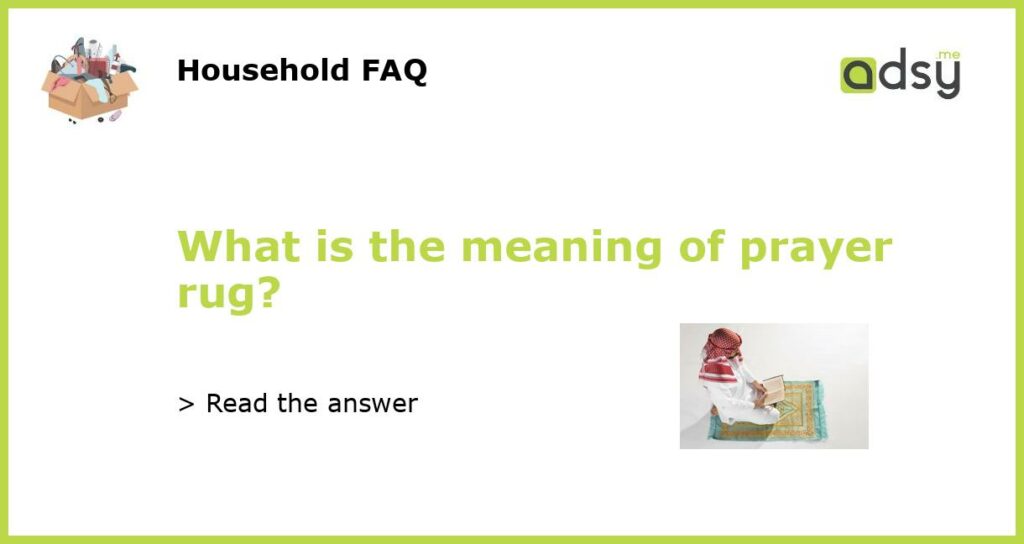The Meaning of Prayer Rug: A Symbol of Devotion and Connection
Prayer is an integral part of religious practice for many individuals around the world. It is a means of connecting with a higher power, finding solace in times of need, and offering gratitude for blessings received. One of the most essential tools in the act of prayer is the prayer rug. But what is the true meaning behind this seemingly simple object? Let us explore the significance and symbolism of prayer rugs in different cultures and religions.
The Purpose and Function of a Prayer Rug
Prayer rugs, also known as prayer mats or prayer carpets, are used by believers of various faiths as a designated space for prayer. They serve both practical and symbolic purposes. From a practical standpoint, these rugs provide a clean and comfortable surface for worshippers to kneel or prostrate themselves during prayer. They act as a barrier between the body and the ground, ensuring cleanliness and facilitating ease of movement.
Symbolically, prayer rugs represent a personal and sacred space for communication with the divine. When unrolled, they create a defined area, demarcating the individual’s space and focus during prayer. This dedicated space allows the worshipper to enter a state of concentration and mindfulness, shutting out distractions and creating a physical and mental environment conducive to establishing a connection with God.
Prayer Rugs across Different Cultures and Religions
While most commonly associated with Islam, prayer rugs are also used in other religious traditions, including Christianity and Buddhism. Each culture and religion brings its own unique symbolism to prayer rugs, enhancing their meaning and significance.
The Symbolism of Islamic Prayer Rugs
In Islam, the prayer rug holds deep cultural and religious symbolism. It is considered a sacred object and a visual reminder of the believer’s duty to perform the daily ritual of prayer. Islamic prayer rugs often feature intricate geometric designs or floral patterns, typically with a mihrab (an ornamental niche) that indicates the direction of Mecca, the holiest city in Islam. This helps worshippers align themselves correctly during prayer, facing the Kaaba (the sacred building at the center of the Great Mosque of Mecca).
Islamic prayer rugs also symbolize purity and cleanliness. Muslims are required to perform ablution (ritual cleansing) before prayer, and the rug serves as a clean and dedicated space for this act of worship. The act of unrolling the prayer rug and kneeling upon it is a physical representation of setting aside worldly concerns and preparing oneself for spiritual communion.
Christian and Buddhist Prayer Rugs
In Christian practice, prayer rugs are less common and are primarily used in Eastern Orthodox traditions. These rugs, often called orlets, are typically embroidered with religious symbols and are used during private prayer or as a focal point during meditation.
In Buddhism, prayer rugs are known as Zabuton or Zafu cushions. These cushions are used primarily during seated meditation or for kneeling during chanting. Zafu cushions are traditionally round and stuffed with kapok or buckwheat hulls, providing support and comfort during extended periods of meditation.
Cultivating Devotion and Focus
Regardless of the specific culture or religion, prayer rugs hold an important place in the spiritual lives of those who use them. They serve as a physical reminder of the importance of prayer, creating a designated space for connection and devotion. The act of unrolling a prayer rug and assuming a prayerful position can stimulate a sense of reverence, mindfulness, and focus. Whether it is the intricate designs of Islamic prayer rugs or the simplicity of Christian or Buddhist prayer rugs, these objects play a vital role in establishing a connection with the divine.
Prayer rugs are not merely decorative or functional items; they are sacred tools that facilitate the spiritual journey of believers. Their meaning goes beyond their materialistic value, extending into the realm of faith, tradition, and personal devotion. Whether it be through Islamic prayer rugs, Eastern Orthodox orlets, or Buddhist Zafu cushions, prayer rugs offer a space for believers to engage with their religious practices and deepen their connection to their higher power.






